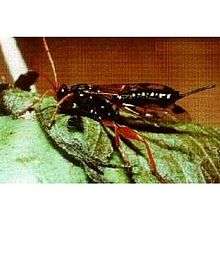Lissopimpla excelsa
| Lissopimpla excelsa | |
|---|---|
 | |
| Scientific classification | |
| Kingdom: | Animalia |
| Phylum: | Arthropoda |
| Class: | Insecta |
| Order: | Hymenoptera |
| Family: | Ichneumonidae |
| Genus: | Lissopimpla |
| Species: | L. excelsa |
| Binomial name | |
| Lissopimpla excelsa Costa | |
| Synonyms | |
|
Lissopimpla semipunctata Kirby | |
Lissopimpla excelsa, commonly known as the orchid dupe wasp, is a Wasp of the family Ichneumonidae native to Australia. Although also found in New Zealand it has probably been introduced there.[1] It pollinates all five Australian members of the orchid genus Cryptostylis . The male wasp mistakes the flower parts for a female wasp and attempts to copulate with it. Although the different species can occur together, they appear to inhibit cross-fertilisation and no hybrids are found in nature.[2] This discovery was made by Australian naturalist Edith Coleman in 1928. The term "pseudocopulation" has since been coined to describe the phenomenon. The mimicking of flowers to resemble female wasp parts has since been recorded in other orchid genera.[3]
Although termed pseudocopulation, vigorous copulation does occur, and the male wasp ejaculates enough so that the emissions are visible to the naked eye on the flower parts. A 2008 field study showed these to contain wasp sperm.[4] The flowers of Cryptostylis orchids and female wasp body parts are very similar in colour when viewed under a hymenopteran visual system, despite looking unlike to human eyes. Although the colours that ichneumon wasps see are unknown, bees and wasps have similar perception with green, blue and ultraviolet wavelengths.[5] The Cryptostylis flowers have no smell detectable to humans, but have been shown to have an odour which attracts the wasp.[6]
The orchid dupe wasp was first described by Italian entomologist Achille Costa in 1864 as Pimpla excelsa, before being placed in (and becoming the type species of) the new genus Lissopimpla in 1889 by Joseph Kriechbaumer, who called it Lissopimpla octo-guttata Kriechb. It was also known for many years as Lissopimpla semipunctata, however Costa's name has priority and hence is the correct name.[1] The wasp is predominantly dark with white spots on its abdomen.[7] Like all members of its family, L. excelsa is parasitic. One species it preys upon is the noctuid moth pest species Helicoverpa armigera.[8]
References
- 1 2 Parrot, Arthur W. (1952). "New Zealand Ichneumonidae II". Transactions and Proceedings of the Royal Society of New Zealand 1868-1961. 80: 155–57. Retrieved 22 November 2010.
- ↑ Robert L. Dressler (1993). Phylogeny and classification of the orchid family. Cambridge, UK: Cambridge University Press. p. 134. ISBN 0-521-45058-6. Retrieved 22 November 2010.
- ↑ Rod Peakall (2007). "Pollination by Sexual Deception in Australian Terrestrial Orchids". Australian National University website. Canberra, ACT: Australian National University. Retrieved 22 November 2010.
- ↑ A. C. Gaskett; C. G. Winnick; M. E. Herberstein (2008). "Orchid Sexual Deceit Provokes Ejaculation" (PDF). The American Naturalist. 171 (6): 000–000. doi:10.1086/587532. PMID 18433329. Retrieved 22 November 2010.
- ↑ A. C. Gaskett; M. E. Herberstein (2010). "Colour mimicry and sexual deception by Tongue orchids (Cryptostylis)" (PDF). Naturwissenschaften. 97: 97–102. doi:10.1007/s00114-009-0611-0. Retrieved 22 November 2010.
- ↑ Schiestl, Florian P.; Peakall, Rod; Mant, Jim (2004). "Chemical communication in the sexually deceptive orchid genus Cryptostylis". Botanical Journal of the Linnean Society. 144 (2): 199–205. doi:10.1111/j.1095-8339.2003.00249.x.
- ↑ Phillip Hadlington; Judith A. Johnston (1998). An introduction to Australian insects. Randwick, New South Wales: UNSW Press. p. 82. ISBN 0-86840-465-9. Retrieved 22 November 2010.
- ↑ Peter T. Bailey (2007). Pests of field crops and pastures: identification and control. Collingwood, Victoria: CSIRO Publishing. p. 274. ISBN 0-643-06758-2. Retrieved 22 November 2010.